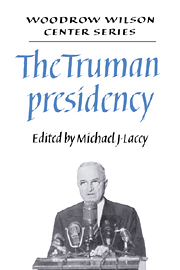Book contents
- Frontmatter
- Contents
- Acknowledgments
- Introduction and summary: The Truman era in retrospect
- 1 The mind and character of Harry S. Truman
- Part I Domestic politics and issues
- Part II Foreign policy and national defense
- 7 The national security state reconsidered: Truman and economic containment, 1945–1950
- 8 The insecurities of victory: the United States and the perception of the Soviet threat after World War II
- 9 Alliance and autonomy: European identity and U.S. foreign policy objectives in the Truman years
- 10 U.S. policy in the Near East: the triumphs and tribulations of the Truman administration
- 11 Toward a post-colonial order: Truman administration policies toward South and Southeast Asia
- 12 Occupied Japan and the cold war in Asia
- 13 The Truman administration and the Korean War
- About the authors
- Index
9 - Alliance and autonomy: European identity and U.S. foreign policy objectives in the Truman years
Published online by Cambridge University Press: 06 October 2009
- Frontmatter
- Contents
- Acknowledgments
- Introduction and summary: The Truman era in retrospect
- 1 The mind and character of Harry S. Truman
- Part I Domestic politics and issues
- Part II Foreign policy and national defense
- 7 The national security state reconsidered: Truman and economic containment, 1945–1950
- 8 The insecurities of victory: the United States and the perception of the Soviet threat after World War II
- 9 Alliance and autonomy: European identity and U.S. foreign policy objectives in the Truman years
- 10 U.S. policy in the Near East: the triumphs and tribulations of the Truman administration
- 11 Toward a post-colonial order: Truman administration policies toward South and Southeast Asia
- 12 Occupied Japan and the cold war in Asia
- 13 The Truman administration and the Korean War
- About the authors
- Index
Summary
“Pax Americana” is a resonant term that conceals a crucial question: How much power and control did the United States exert in postwar Europe? U.S. policy involved organizing a coalition of nations, encouraging European leaders who shared the political objectives of the United States, and seeking to isolate those who did not. It meant using economic assistance as well as the appeal of a liberal ideology to reinforce centrist political preferences among European voting publics and working-class movements. At the same time Washington policy makers were supposedly committed to encouraging European autonomy. How did alliance and autonomy mesh? In some instances one goal might have to yield, at least temporarily. Consider, for example, the dilemma presented as late as 1951 by government fecklessness in Greece (admittedly the feeblest of the regimes in the U.S. orbit). William Foster at Economic Cooperation Administration (ECA) headquarters in Paris might wire officials in Athens that “any further assumption of responsibility for managing Greek affairs, despite recurring evidence that a weak government prefers to pass responsibility for potentially unpopular decisions, … could ultimately evolve into colonial relationship between Greece and U.S. which, of course, is wholly contrary to American objectives.” But the mission in Athens responded, “It appears to us that, US aid being decisive factor in maintaining Greek stability, ‘intervention’ is a concomitant of our position. Insistence on sound performance is obligation we cannot escape.”
- Type
- Chapter
- Information
- The Truman Presidency , pp. 273 - 298Publisher: Cambridge University PressPrint publication year: 1989
- 12
- Cited by



